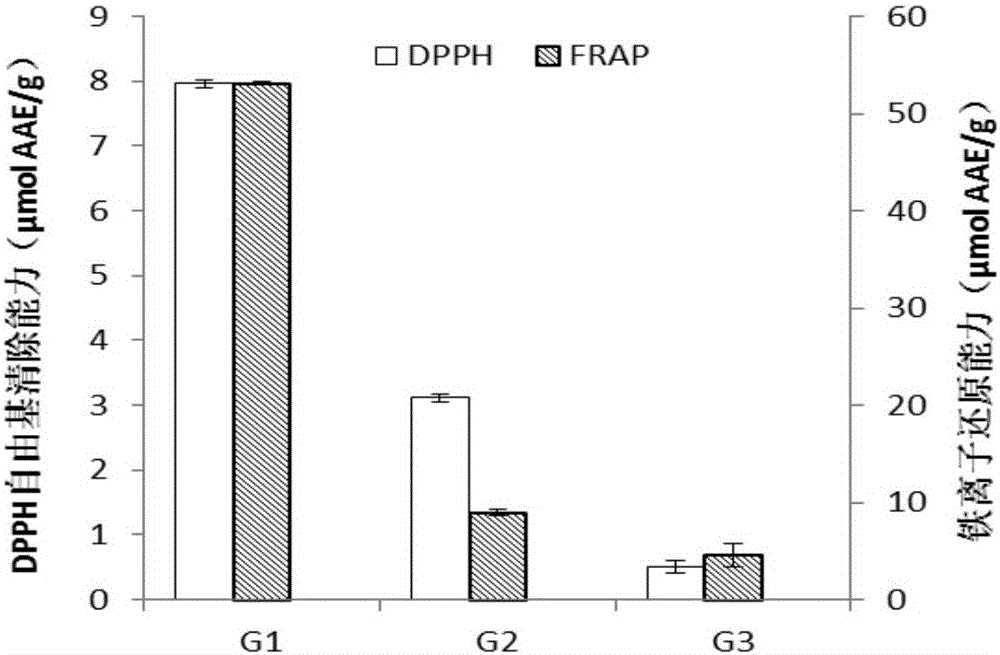Antioxidant peptide mixture and preparation method thereof
A technology of antioxidant peptides and mixtures, applied in the biological field, can solve problems such as low utilization rate, achieve the effects of reducing resource waste and pollution, simple steps, and improving commercial value and utilization rate
- Summary
- Abstract
- Description
- Claims
- Application Information
AI Technical Summary
Problems solved by technology
Method used
Image
Examples
Embodiment 1
[0040] Step 1 Shrimp by-product pretreatment
[0041] Wash the remaining shrimp heads and shells after peeling off the shells of Penaeus vannamei, put them in a constant temperature drying oven at 60°C for 16 hours, crush them with a multipurpose grinder, and pass through a 60-mesh sieve.
[0042] Determination of optimal extraction time of total protein of shrimp by-product in step 2
[0043] Weigh 0.4g of shrimp shell powder, add it into 6mL phosphate buffer (0.05mol / L, pH8.0), and incubate at 37°C for 0.25, 0.5, 0.75, 1, 1.5, 2, 3, 4 and 6h respectively . The total protein concentration was determined using a Bradford kit. The results showed that the concentration of water-soluble shrimp protein gradually increased with the increase of extraction time within 0-2 hours, and the concentration of water-soluble shrimp protein reached 23.14% at 1.5 hours, and 23.49% at 2 hours. Thereafter, the concentration of water-soluble shrimp protein obtained in 3, 4 and 6 hours did not ...
Embodiment 2
[0057] The antioxidant activity determination of the antioxidant peptide mixture obtained in embodiment 1
[0058] Step 1 Determination of DPPH free radical scavenging rate: Ascorbic acid and deionized water were used instead of samples as positive and negative control groups. DPPH solution preparation: 3mgDPPH was added to 100mL methanol and fully dissolved. Take 1 mL of sample, add 4 mL of DPPH solution, place it in a dark room at room temperature for 30 min, and measure the absorbance at 517 nm. Set different concentrations of ascorbic acid and draw a standard curve. The DPPH free radical scavenging rate is calculated according to the following formula:
[0059]
[0060] In the formula: A 1 is the absorbance value of DPPH solution after adding hydrolyzate; A 2 is the absorbance value of the hydrolyzate; A 3 is the absorbance value of DPPH solution without adding hydrolyzate.
[0061] Step 2 Determination of iron ion reducing ability: ascorbic acid and deionized wat...
PUM
 Login to View More
Login to View More Abstract
Description
Claims
Application Information
 Login to View More
Login to View More - R&D
- Intellectual Property
- Life Sciences
- Materials
- Tech Scout
- Unparalleled Data Quality
- Higher Quality Content
- 60% Fewer Hallucinations
Browse by: Latest US Patents, China's latest patents, Technical Efficacy Thesaurus, Application Domain, Technology Topic, Popular Technical Reports.
© 2025 PatSnap. All rights reserved.Legal|Privacy policy|Modern Slavery Act Transparency Statement|Sitemap|About US| Contact US: help@patsnap.com



